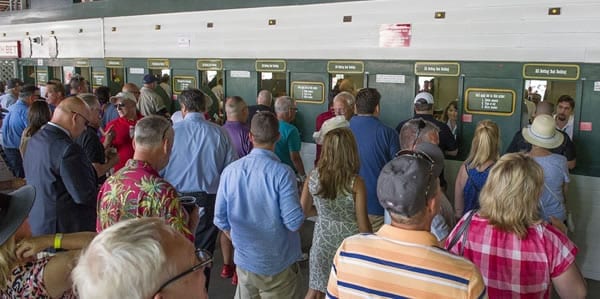Betting to Place in Horse Racing

What is a Place Bet?
When you bet to place your horse must finish first or second in order for you to cash a ticket. The payoffs are understandably lower on winning place bets because the place pool (all money wagered to place on a race minus the track takeout) is split between two horses – the horse that wins the race and the horse that finishes second.
But while the payoffs are lower for place bets, there are certain situations in which place betting can be lucrative. In fact, some very intelligent gamblers make a living simply by waiting for overlays in the place pools.
Unlike win betting, in which you can see approximately what your horse will pay to win on the tote board before the race runs, determining what your horse will pay to place requires you to do some calculating based on the place pool. The total amount of money bet into the place pool on a race, and the amount bet to place on each horse, is displayed on the tote board at most modern racetracks.
While the calculations required to determine place payouts may seem like too much work for a casual bettor, a patient handicapper with reasonable skills can make a profit on place betting alone. Additionally, intelligent place betting can help you avoid occasional losing streaks experienced by even the sharpest bettors.
Calculating the Payout
A reasonably accurate method of calculating what your selection will pay to place is to add all the money bet on your choice to place, as shown on the tote board, to all the money bet on the favorite to place. Or, if your selection is the favorite, add all the money bet on the favorite to place to all the money bet on the second choice to place. You then subtract that amount from the total place pool amount and subtract a further 15 percent for track take out and breakage. The amount of money left over after these calculations is approximately what will be divided among the holders of winning place tickets. Keep in mind that if the favorite runs out of the money, the payoffs will obviously be higher, but what we want to calculate is the approximate minimum we would get back for our wager.
For example:
Total amount of money bet into the place pool = $48,000
Amount remaining after 15 percent track takeout = $40,800
Total amount bet on the favorite to place = $20,000
Total amount bet on your selection to place = $12,000
Total profit to be split equally among winning place bettors = $40,800 – ($20,000 + $12,000) = $8,800
$8,800/2 = $4,400 to be paid back to holders of place tickets on the favorite (the winner) and $4,400 to be paid back to place ticket holders on the second place finisher.
To calculate the amount the favorite will pay to place: $4,400/$20,000 = $0.22 per dollar wagered.
Rounding off the $0.22 for breakage the payout becomes $0.20 per $1 wagered.
A $2 place bet on the favorite would return approximately $2.40.
To calculate the amount your choice would pay to place: $4,400/$12,000 = $0.36 per dollar wagered.
Rounding of $0.36 for breakage the payout becomes $0.30 per $1 wagered.
A $2 place bet on your selection would return $2.60.
The above calculations assume that the favorite either runs first or second. If the favorite runs out of the top two spots, the place payout will be larger, simply because the money bet on the favorite to place is now available to the holders of winning place tickets.
If you really like a horse other than the favorite, and you think there is an excellent chance that the favorite can finish out of the top two spots, you may have found yourself a good opportunity to bet to place or even win-place. A solid wagering strategy, in this case, might be to bet twice as much to place as you bet to win. If your horse fails to win but still finishes second, and the favorite runs out of the top two spots, your doubled up place bet will in all likelihood produce a decent profit.
Another scenario where it pays to bet to place is when your selection, even if it happens to be the favorite, is an overlay in the place pools. For example, if 50 percent of the win pool has been bet on your selection, but only 25 percent of the place pool has been bet on your selection, you have found yourself an overlay.
In numerical terms, if $5,000 of the $10,000 win pool has been bet on your selection, that equals 50 percent of the pool. If only $1,000 of the $4,000 place pool in the same race has been bet on your selection, that equals only 25 percent of the pool, or a 100 percent overlay.
In reality, finding 100 percent overlays in the place pool is a rarity, but finding overlays of between 25-35 percent is not uncommon. Waiting for and spotting these types of overlays requires great patience and a trained eye for the tote board, but they can increase your odds of making a profit and beating the 15-20 percent track takeout.
Finally, if you really like a horse at odds of better than 5-1, a win bet is probably the play. But, if your selection is 9/2 or less and the favorite is lukewarm odds of 8/5 or higher, a place bet or win-double-place bet can be a solid alternative to win betting. One that offers a good chance of making a profit while at the same time reducing your risk.



